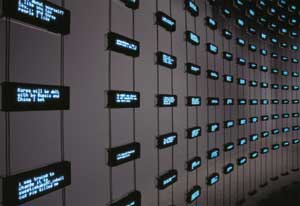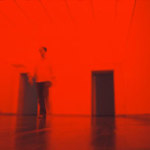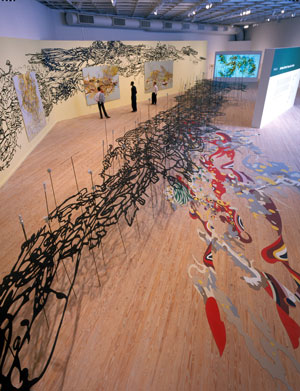Some forty years ago, “Sound and Light” gallery shows were all the rage. The art world buzzed with rhetoric about pop, participation and the merging of art and technology. Synched-up multi-sensory artworks trumpeted the dawn of a new interactive utopia and critics noted the failings of a hopelessly kitsch “novelty art”. Remnants of the sixties’ kinetic light-show craze, and the far longer history of dazzling public spectacle are still with us. Where high municipal ambition and minor historical interest coincide, one can sometimes find “Son et Lumière” displays bathing monuments in multicolored lights, canned music and a voiceover history.
The MIT List Gallery’s own “Son et Lumiere” exhibition (Feb 12-April 4), curated by Bill Arning, casts some fresh light on the relation between multi-media installation, interactive public space, and history. Some of the six pieces, such as Jessica Rylan’s Voice of the Theater, Michael Mittelman’s Hallway and Bruce Bemis’ Bipolar Radiance absorb and use a faintly nostalgic atmosphere, others, like Mark Hansen and Ben Rubin’s Listening Post embrace more sophisticated means. Each of the six pieces in the show goes outside of cinematic projection in order to fashion something poignant out of light, sound and silence. The show’s successes in this regard are a little uneven, but its sharper moments are as emotionally engaging as they are stimulating.
I like jalapenos. I like naughty stuff. I love German naval history. I love homemade bread. I love ya dallas! I like it in all diffrnt positions. I love that text. I like that better than processed meat.
A computer generated voice scuttles between total banality and ready-made poetry while across a gently arching curtain of small display screens blue text flashes like phosphorescence on the surface of the matrix. It continues:
I love talkin shit. I like u anyway. I love the truth. I like things that are real. I like to kill terrorists. I love the smell of jasmine. I like poptarts!
We love to hear fragments of other people’s conversations. We like the pathos and absurdity of the human spectacle. We like to identify with some people. We love our complete alienation from others. And judging from the reactions to Mark Hansen and Ben Rubin’s Listening Post, we love art’s voyeuristic pleasures. Using data-mining technology, the work puts an ear to the thin walls of thousands of internet chat rooms where folks tap out their hopes, desires, opinions and seemingly everything else about themselves. In one sequence, great waves of “chatter” rush over the wall-sized curtain. That small inkling of the massive quantity of verbiage the work sorts through is nothing short of sublime. The phrases it snatches out of context and illuminates before us are by turns ridiculous, frightening, predictable and bizarre. Some revolve loosely around religious and political themes. At times the voices stumble over misspellings, phrases overlap and multiply into nonsense. In another cycle, the synthesized voices intone variations on “I am”:
I’m a lesbian. I’m not from Canada. I am 13. I am sorry watching Elvis. I’m a redneck. I’m noooo way a nun!!! I’m looking for love. I am really considering voting for Nader. I’m sour on women. I’m depressed. I am Russian sexual bear.
The urgent melody accompanying the “I like” and “I am” cycles is a little too reminiscent of standard Son et Lumière melodrama, but the plucked bass tones, clicking text, isolated beeps, pings and deep wowing tones otherwise reflect the tremendous polyphony of the chatter. The text fragments are decontextualized, but there is no taking the work itself out of the historical moment. Perhaps more frightening than some of the opinions and attitudes of the netizens is that the Listening Post seems a benign application of a potentially sinister technology. In the Total Information Awareness age there might be many ears on the walls of chat rooms.
The Listening Post is technologically and aesthetically the most outstanding work in the show, but others are able to put us in touch with an absent, anonymous social body through less sophisticated means. Jennifer Allora and Guillermo Calzadilla’s Traffic Patterns consists of a room completely empty save for lights behind a drop ceiling, showering it in alternating green, amber and red light. On the surface it seems a Turrell or Flavin redux, but the lights are programmed to match a single stoplight in San Juan, Puerto Rico. Knowing this provokes a sort of astral projection to that spot where they determine gas pedal or brake. Although the work doesn’t quite cohere as “an absurd monument to the intractability of [post-colonial] political inequalities” as the wall text suggests, it certainly manifests split consciousness, conjuring the heat, bustle and fumes of San Juan out of an antiseptic gallery installation.
Although most of the work avoids cinematic projection, some of them feel like a film set. Just beyond the exhibition’s own entrance lies an unassuming portal into Michael Mittelman’s 14-foot long Hallway. Entering this slightly oppressive space, you find yourself in an uncanny mock up of, say, grandma’s hall of family photographs. Instead of the assorted weddings, cousins and long dead ancestors, however, you’ll find only your own reflection in shiny jet-black panes. Vaporous moans and shuddering walls add to the house-of-horrors pretense and in the blacked out window at the end of the hall spectral images of your predecessors, and eventually yourself, make fleeting appearances. The time delay discourages mugging at the camera, but only just. Antics are eventually rewarded, but it is catching sight of yourself repeating an unselfconscious gesture that’s surprisingly unnerving. Mittelman’s Hallway invites you to star in your own straight-to-video horror flick, but cutting through the artifice is a rather effective memento mori. That combination of prefabricated suburban architecture, surveillance technology and death strikes an ironic tone, but it is difficult to gauge how seriously the work takes itself. The same could be said of Ann Lislegaard’s Corner Piece, where bright lights behind a false corner flash in sync to the breathless whispers of anxious female lovers.
Perhaps Son et Lumière’s success lies in that poise between genuine sentiment and ironic detachment. To its credit, the exhibition makes no outsized claims for technological sophistication, preferring to look at how technology inhabits our fantasy life, shaping and revealing our likes, loves and the humanity of it all.
I’m counting UFOs. I’m from Texas. I am 50,053. I’m a Muslim. I am a nice girl. I am ready for summer…
- Jennifer Allora & Guillermo Calzadilla; Traffic Patterns, 1999-2003 (as installed at The Americas Society, N.Y., N.Y.); Drop Ceiling, controller/relay system synchronized to traffic light in San Juan, Puerto Rico; Dimensions variable; Courtesy of the artists; Photo courtesy of The Americas Society and Allora & Calzadilla.
- Jennifer Allora & Guillermo Calzadilla; Traffic Patterns, 1999-2003 (as installed at The Americas Society, N.Y., N.Y.); Drop Ceiling, controller/relay system synchronized to traffic light in San Juan, Puerto Rico; Dimensions variable; Courtesy of the artists; Photo courtesy of The Americas Society and Allora & Calzadilla.
- Mark Hansen and Ben Rubin; Listening Post, 2002 (as installed at the Whitney Museum of American Art, N.Y., N.Y.); 231 miniature text display screens and other electronic components, copper wire, aluminum, loudspeakers, and software; 21 x 14 x 3 feet; Courtesy of the artists; Photo by David Allison.
----
Links:
LVAC / MIT
Jessica Rylan
Michael Mittelman
Hansen and Rubin at the Whitney
Allora and Calzadilla at the Tate
All images are courtesy of the List Visual Arts Center at MIT, Cambridge, MA.
“Son et Lumiere” is on display between February 12th – April 4th at the List Visual Arts Center at MIT, Cambridge, MA.
Tyler Cann is a doctoral candidate in the history of art department at Harvard University. He is ready for summer too.







